Chinese Nationalist Party (KMT) Chairman Wu Den-yih (吳敦義) was inaugurated yesterday during the party’s 20th National Congress in Taichung, and the party’s platform was amended to rescind a proposal to seek a peace treaty with China.
In his inaugural address, the former vice president stressed the so-called “1992 consensus” and pledged to reconnect the party with the nation’s young people and boost the economy to revive the party.
He reiterated the “original wording” of the “1992 consensus”: that “both sides of the Taiwan Strait should adhere to the ‘one China’ principle, but both sides agree to make its own interpretation of what that means in oral form.”

Photo: CNA
“On the basis of the 1992 consensus,’ we will continue to oppose Taiwanese independence and promote Chinese culture to facilitate reconciliation and mutual respect between two sides of the Taiwan Strait,” Wu said.
The “1992 consensus” — a term former Mainland Affairs Council chairman Su Chi (蘇起) said in 2006 that he had made up in 2000 — refers to a tacit understanding between the KMT and the Chinese government that both sides acknowledge there is “one China,” with each side having its own interpretation of what “China” means.
Former president Ma Ying-jeou’s (馬英九) administration inked 23 bilateral agreements with China due to its adherence to the consensus, Wu said.
Wu’s speech marks a return to the KMT’s long-standing “one China, different interpretations” framework after former KMT chairwoman Hung Hsiu-chu (洪秀柱) favored a pro-unification “one China, same interpretation” framework.
However, Hung criticized the new amendment, saying that it “dilutes the ‘one China’ principle and stresses ‘different interpretations,’” which she feared would be interpreted by Beijing as an announcement of “Republic of China [ROC] independence” — an idea promoting an independent Taiwan under the ROC framework.
The “1992 consensus” underlines both the “one China” principle and unification, and Wu’s platform only deals with the former part without advancing cross-strait relations to the “deep-water zone,” she said.
The national congress also approved an amendment to the party platform drafted by Wu to revoke a proposal to negotiate a peace agreement with China to end hostilities that Hung pushed through to the party platform last year.
The KMT’s platform now stresses the “different interpretations” framework while professing a “firm opposition to Taiwanese independence” to “maintain the status quo of ‘no unification,’ ‘no independence’ and ‘no war’” to achieve “peaceful and stable development in cross-strait relations.”
The platform also vows to build an honest and efficient government, develop the economy and equal distribution of wealth, create a just and harmonious society, build a sustainable environment and ensure peace in cross-strait relations.
Wu also apologized for the landslide defeat the KMT suffered in last year’s general elections, in which the party lost both the presidency and the legislative majority to the Democratic Progressive Party (DPP) for the first time.
To resuscitate the KMT, Wu promised to reconnect with the youth and put forward economic policies.
The KMT is to recruit, train and promote younger party members while supporting social campaigns launched by young people, while a volunteer service unit consisting of younger KMT members is to be organized to connect with voters in urban, rural and remote areas.
Wu asked officials from the municipalities governed by the KMT to improve local business environments to attract investments and create jobs.
While disunity between KMT headquarters and its caucus marked Hung’s term, Wu called for a closer collaboration between the party’s sub-organizations, with the KMT caucus asked to take advice from local chapters and think tanks.
The KMT has to gain ground in next year’s mayoral and councilor elections — the first major test of the party since last year’s devastating defeat — if it wants to regain the presidency and legislative majority in the 2020 general elections, Wu said.
The new KMT leader also criticized the DPP government for the cross-strait deadlock, what he called a divisive push for pension reform, the Forward-looking Infrastructure Development Program budget and the exodus of Taiwanese businesses and workers.
The DPP administration, during the course of pension reform, has provoked conflict along occupational lines, with public employees bearing the brunt of pension reform, he said.
The four-year, NT$420 billion (US$13.8 billion) development project could not solve the shortages in power, water, workforce and development, but aims to disperse pork-barrel projects to local political operatives, he said.
Wu vowed to lead the KMT to prosperity and reform to solve a variety of dilemmas the nation is facing.
In other developments at the congress, KMT vice chairmen Hau Lung-bin (郝龍斌) and Tseng Yung-chuan (曾永權) were officially sworn for new terms.

TPP RALLY: The clashes occurred near the Chiang Kai-shek Memorial Hall on Saturday at a rally to mark the anniversary of a raid on former TPP chairman Ko Wen-je People who clashed with police at a Taiwan People’s Party (TPP) rally in Taipei on Saturday would be referred to prosecutors for investigation, said the Ministry of the Interior, which oversees the National Police Agency. Taipei police had collected evidence of obstruction of public officials and coercion by “disorderly” demonstrators, as well as contraventions of the Assembly and Parade Act (集會遊行法), the ministry said in a statement on Sunday. It added that amid the “severe pushing and jostling” by some demonstrators, eight police officers were injured, including one who was sent to hospital after losing consciousness, allegedly due to heat stroke. The Taipei

NO LIVERPOOL TRIP: Taiwan’s Lin Yu-ting, who won a gold medal in the boxing at the Paris Olympics, was embroiled in controversy about her gender at that event Taiwanese boxer Lin Yu-ting (林郁婷) will not attend this year’s World Boxing Championships in Liverpool, England, due to a lack of response regarding her sex tests from the organizer, World Boxing. The national boxing association on Monday said that it had submitted all required tests to World Boxing, but had not received a response as of Monday, the departure day for the championships. It said the decision for Lin to skip the championships was made to protect its athletes, ensuring they would not travel to the UK without a guarantee of participation. Lin, who won a gold medal in the women’s 57kg boxing

‘NOT ALONE’: A Taiwan Strait war would disrupt global trade routes, and could spark a worldwide crisis, so a powerful US presence is needed as a deterrence, a US senator said US Senator Deb Fischer on Thursday urged her colleagues in the US Congress to deepen Washington’s cooperation with Taiwan and other Indo-Pacific partners to contain the global security threat from China. Fischer and other lawmakers recently returned from an official trip to the Indo-Pacific region, where they toured US military bases in Hawaii and Guam, and visited leaders, including President William Lai (賴清德). The trip underscored the reality that the world is undergoing turmoil, and maintaining a free and open Indo-Pacific region is crucial to the security interests of the US and its partners, she said. Her visit to Taiwan demonstrated ways the

The US has revoked Taiwan Semiconductor Manufacturing Co’s (TSMC, 台積電) authorization to freely ship essential gear to its main Chinese chipmaking base, potentially curtailing its production capabilities at that older-generation facility. American officials recently informed TSMC of their decision to end the Taiwanese chipmaker’s so-called validated end user (VEU) status for its Nanjing site. The action mirrors steps the US took to revoke VEU designations for China facilities owned by Samsung Electronics Co and SK Hynix Inc. The waivers are set to expire in about four months. “TSMC has received notification from the US Government that our VEU authorization for TSMC Nanjing